Andrew Bolt* gave a performance so untruthful and offensive on the weekend Insiders, that I really think he has got to be having this shit fed to him and rehearsed beforehand. No one could honestly hold this many stupid views in one head. His positions on the weekend once again included his greenhouse denial schtick, along with saying that the Coalition actually believes his view on the subject and are just faking it with a token effort to allow for a change of subject. He also used the current lie-attack approach with respect to Ross Garnaut. I hesitate to tell you about it, but will risk spreading its use, as I think it is important to be able to identify it when you see it, as it fits into a wider ploy by cultural conservatives and shills of big business. The lies that Dolt was allowed to share included:
• The lie is that there is zero risk to Australia due to the nuclear accidents in Japan caused by the earthquake, and then tsunami.
• The lie that the Greens will just use this as a beat up so they can stymie the development of nuclear power
• The lie is that Ross Garnaut is not credible to listen to for any reason on the climate change issue, as he is only an economist, and not a climate scientist, and he is paid by the government for his views.
The lies fit into a broader tactic by the cultural conservatives of doing something really shitty, then accusing you of it, falsely and in a pre-emtory manner, to hide their “crime”. They did it to Tim Flannery a couple weeks ago on Q&A, and I’ve heard it from another Coalition climate change denier a week before that.
And Dolt does it here again. Because this time, he used one lie to sell another. While attacking Ross Garnaut’s credibility on one issue, he used Ziggy Switkowski, who has not worked in the nuclear power industry ever to my knowledge, and while very involved with ANSTO as a director, his degree in nuclear physics has got to be 35 years old. After getting his business degree at Harvard, he served in series of company management roles, including Telstra. There is also the fact that he is a big proponent of nuclear power in Australia. Why shouldnt he be, as he was appointed by the Howard Government to look into the nuclear power issue. But hey, not that it is such a bad thing. As I have said before, there is a role for nuclear power in getting us off the magic dirt. Ziggy isn’t a bad guy, and I think he is smart and does have credibility on his issues.
Just like Ross Garnaut does. But Dolt smears Ross as a paid government lackey, and treats a distinguished, professor, diplomat, researcher and company chairman as if he was a one trick pony. And the funny thing about this smear is that it exposes the stupidity of Dolt. Having an economist study climate change and report on its effects is precisely the person to have do it on behalf of the government. You want to have a dispassionate and non-partisan person evaluate the cause and effects that can also apply the scientific method.
But the deniers first act these days is to now say that any scientist on your side of an argument has no credibility, as his field is not exactly climate science. This is a vile and disingenuous strawman of an argument and needs to be exposed. They have no basis upon which to be supported by a consistent theory and evidence in science, so they attack all science itself. Tim Flannery is just a geologist. By that measure, we have no reason to believe Isaac Newton, a farmer who was trained as a mathematician.
But then the bastard went on. Dolt also downplayed the significance of a nuclear incident on the 200,000 evacuated, in the hundreds of those exposed to heightened radiation, some needing treatment, and the potential future risk (at the time on Sunday morning) by saying we should be worrying about the missing. How about we worry about them all, you fucking moron. How about we make a serious effort to address the probable meltdown of two nuclear reactors at about 8 effected by the quakes and tsunami while we also mobilise in the millions people to find the wounded, bury the dead and start to rebuild their lives. Andrew Bolt abused the suffering of one effected people to make his point (a lie, I remind you) about another. He is the worst of humans and should be forced to go work on the recovery and containment effort directly at the site of the nuclear plant where the hydrogen explosion took place on Sunday morning, with his wife and kids (if he has any) living in a nice camp trailer across the street.
So basically, let’s leave this idiot behind, and work into some facts about the reactors in Japan, figure out where we are at, and put together evidence for the future. How about that? Right, well the first thing we want to do is understand what we are dealing with here through some research. Then we will put some facts into context and see where to go from there.
The first thing to understand is that the reactors that have released radioactive caesium and have had to have radioactive steam vented from them (indicators of a probable meltdown) are boiling water reactors (BWR) from the 1970s. Wiki says:
“The family of nuclear reactors known as light water reactors (LWR), cooled and moderated using ordinary water, tend to be simpler and cheaper to build than other types of nuclear reactor; due to these factors, they make up the vast majority of civil nuclear reactors and naval propulsion reactors in service throughout the world as of 2009. LWRs can be subdivided into three categories – pressurized water reactors (PWRs), boiling water reactors (BWRs), and supercritical water reactors (SWRs). Various agencies of the United States Federal Government were responsible for the initial development of the PWR and BWR.”
So as not to confuse anyone, radioactive caesium (Caesium-137) has a half-life of about 30 years, decays by beta emission to barium-137, which is also radioactive (gamma ray emitter) with a half-life of 2.55 minutes. Beta emitters aren’t as big a deal as far as health goes immediately, provided you aren’t too close to a concentrated emission source, but they area chronic health problem generator (cancer) if you consume them. However, gamma radiation is real bad in an acute sense, and this is the radiation that kills people in nuclear blasts and through radiation sickness in months after one. So, once again, the risk posed is an additional cancer causing element that you might be exposed to by ingesting or inhaling radioactive particles from a burning or venting nuclear plant. We have a definite chronic health problem, and a vector by which it is getting into the environment. So, the risk is not zero here in Australia, or anywhere.
Now, how close are we to real real bad in Japan. For that, we have to go back to the engineering of the plants. We now need to know how bad the meltdown is, and whether secondary containment has been broken. I have to get a bit techy again for a moment, so bear with me. In the BWR, the nuclear reaction is used to directly produce steam to run a turbine to make electricity. The nuclear reactor runs on the fission reaction of radioactive uranium, and the control rods used in the reactor control the rate at which the uranium decay reaction occurs. Pull the control rods back – faster. Push them all the way in – very slow. Lose control of the rods, and you lose control of the reaction, and things get as hot as the sun on that little patch of earth. BWR also use a lot of circulating water to control the reaction rate and keep the temperature down while the steam is generated. Lose control of the cooling water, and you can get too hot and lose control of the control rods, and then you go down that bad chain of events again. So, plants like in Japan have double and triple duplicate systems to move cooling water around in a reactor in an emergency. They also have containment systems, with the reactor itself being contained within a 2 metre thick pre-stressed, steel-reinforced, air-tight concrete dome. This is inside a building that also serves as containment. Hydrogen that got broken down from water in the reactor in Japan during this current incident leaked into and then exploded inside the second building that we all saw on tv. You know it is a hydrogen explosion because of the fast shock wave that proceeded the debris of the building being ejected and the lack of fire afterwards.
What we now need to do is find out how the core is. If it’s a melted ball of fuel and rods that doesn’t function at all, then the cleanup may require entombment. If the core was shut down well enough that it still operates as a functioning unit, but was only seriously overheated, the cleanup may be “only” recovering it, cooling it down as far as possible, and salvaging the bits that can be reused. It all depends on the state in which the shutdown got to prior to emergency cooling water loss, how hot the core got, and how much nuclear material melted and where it was finally contained as a solid mass again. We shall see, based on the facts that emerge.
Then, at that time, we will start to debate what the root causes were that led us to this point, whether we knew we might get here before in the evaluation of this plant from 1971 over the years, and the soundness of the logic of having 53 of these facilities in Japan, right on the edge of the ring of fire in seismic terms. Certainly looking at the photos already, we can see that the nuclear plant at Fukushima took the earthquake and tsunami better than the surrounding infrastructure.
Before:

After:

The problem appears to be that while the civil infrastructure held up well, the electrics, piping and backup generation capacities were knocked out by the duel disaster. In most likelihood, the core concrete containment structure was not cracked by the earthquake. But as I said we shall see.
I hear as I upload this that there is another 3 m tsunami headed for NE Japan, and there has been another explosion at Fukushima just now, meaning we now have 2 reactors where this has occurred.
Lets hope those civil engineers got their shit very right, and the cooling water is not lost this time.
But don’t take my word for it, do some research of your own, as I am just a chemical engineer.
* – I am just going to call him Dolt for short now, since it sums him up accurately, and he doesn’t deserve a full human name in my world.